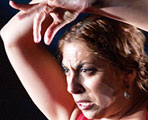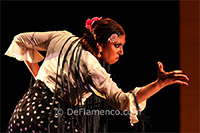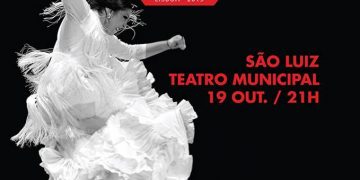Interview: Jorge Fernández Bustos
Photos: Miguel A. Molina
«It?s the urge to dance to the singing»
When I’d already turned off the voice recorder at the end of the interview, Fuensanta La Moneta asked me to turn it on again so she could elaborate on some of the comments. This is a sign of her passionate desire to communicate. Born in Granada, she’s been on a steadily moving and very personal upward path even since 2003 when she won the highest dance award, the Desplante, at the La Unión contest. She’s traveled the globe with her dancing, and is admired whenever she goes. Extremo Jondo is her third staged work which, after a year in preparation, she’s decided to make into a DVD so as to leave a record. We’re particularly interested in this new work and how it’s different from your previous ones. The biggest difference is it’s not a choreographic show in which dance is the centerpiece and the music takes a back seat. This show is based as much on the singing as the dancing, the guitar and the percussion, and dance complements it. Therefore, my dancing takes on a different approach. I’m completely relaxed and free in the dance. What made you decide to make a DVD of Extremo Jondo? We very much wanted to leave a record of this work for the future. It’s not the first time a show has been put together with a minimum of elements, but this is a presentation which is noteworthy because of the teamwork that went into it, and the contrasting quality of the music within a novel framework. That’s why I thought it was important to put this into recorded format, allowing the work to exist beyond the stage. The work debuted at Granada’s Festival de Música y Danza in 2010 at the Isabel la Católica theater, and was recorded in 2011 at the closing of the Veranos del Corral. Has it changed much in all this time? Yes, the work underwent some changes, like all shows do. When you debut a new work and start getting into it, you’re always making changes along the way. The most obvious is that Extremo Jondo debuted with the singer Enrique el Extremeño, and was recorded with Miguel Lavi. The cante is different, but the concept is the same, the communion between voice, dance and guitar. In actual fact, the show changes every time we present it, because there is a great deal of freedom. It’s always surprising, even for us, the things that come out, and which were done on the spur of the moment. Then, in another show, other things change. I knew from the start that basing the show on cante, the dancing would take on a different sort of responsibility. Since it was all so clear, and for everyone else too, the process of putting the show together came about in a natural way. Since the debut and until now, it’s gotten better, but it’s not that different from the first time. Is there much improvisation with each performance? Of course, lots of spontaneity, it couldn’t be any other way. You say the responsibility is shared, but for the duration of the show, you only leave the stage for the bare minimum of time it takes to change costume. Is it because you feel like dancing, or you want to show your strength? It’s obvious I have energy in this body of mine, I don’t have to demonstrate that to anyone, and I don’t have to show off. It’s the urge to dance, to dance a lot and dance to the singing. It probably seems like a paradox, the show is about singing, but I dance everything, I dance the silences, I dance the transitions…everything. And only because I have to change costume sometimes, but if it weren’t for that….. Well, the selection of the cante is complex. In the beginning there was a lot more. I’d chosen many forms which, for a variety of reasons, I felt like dancing, some because I’d never done them before, and others, because I needed to give them another turn of the screw. The selection came about in a natural way. Did you personally make the choices? I selected them myself, but shared the final decision with the musical director who is guitarist Miguel Iglesias, and with the singer. It’s an in-depth work, very thought-out. Has anything been left out? Yes. Things we’ll do later on. There was more, but we had to put some things aside because the work can’t go on eternally. Whom do you look to for inspiration? In this show, since there wasn’t really a lot of choreography, my main reference was the cante. In previous works I looked to the maestros who influenced me directly, people I worked with such as Javier Latorre and Mario Maya. And other people who, although I never worked with them, but whose work I was able to see. The contemporary line comes out once in a while, because I’m young, because I think I’m in the current drift of flamenco and because I’ve come of age with other artists who are now choreographers and make a point of that approach. Such as your contact with Rafael Estévez? Exactly. I was fortunate enough to work with him and soak up his influence. Do your musicians also enjoy that margin of spontaneity? Yes. We’re all on the same team and we all have to walk in the same direction. If I feel free and feel comfortable, it’s thanks to them. So they must also feel free when they’re on stage. I have to give them that opportunity. If not, there’s no dialogue, and the “duende” doesn’t show up when it’s supposed to. Yes, it shows that you’re all in communication. How did you get them for this work? Well, we’re all moving in the same circle and we all know each other. Sometimes you look for them, and other times you bump into them along the way, that’s how it was. This show came out of an experience in Japan where most of the people were who are working with me. People who left their artistic mark on me, which was why I wanted to do this show, to communicate that experience precisely with them. Always very well. They were surprised at the novel minimalism, such a reduced format, with only the basic elements. And it was accepted because the quality was still there. For example, the last place we were was in Nimes, and really, I’m not surprised that they understand this and like it, they’re equally prepared to see an avant-garde show as something more traditional. In fact we’ve been doing the show both in and out of Spain. I’m very interested in seeing how things develop from now on, since we’re going to mostly be moving the show within Spain. And in that way the show keeps evolving. Right. Because it’s alive, it’s really alive. And yet, there are some things in your dancing that never change and have been with you since the beginning. What would you say those things are? Yes, there are some things in my dancing that don’t change, certain characteristics. Although I might follow a more contemporary line, the Moneta of years ago when I didn’t have as much experience is still there, when I was still learning and I continue to learn even now. When I started dancing, all I wanted was to dance, it was my dream. There was a lot of intuition involved, and I don’t think I’ve lost that. That characteristic of La Moneta still shows. One of the constants might be the tango ending? Of course, because it’s one of the dances I began with and because tangos are representative of Granada. Yes, that’s characteristic. And although I think I’m a bit more controlled, the spirit is still there. How do you see the future, what’s your next project? We’ve always got projects, because I don’t like to stand still, I want to keep on with my work. I have something in mind which I’ll begin working on in the studio. I hope to have it ready before the end of this year.
|
Descubre más desde Revista DeFlamenco.com
Suscríbete y recibe las últimas entradas en tu correo electrónico.




 It seems the work is still changing, like it’s alive. How do you handle that evolution?
It seems the work is still changing, like it’s alive. How do you handle that evolution? Speaking of Japan, Extremo Jondo has been performed abroad. How did people react in other countries?
Speaking of Japan, Extremo Jondo has been performed abroad. How did people react in other countries?






















